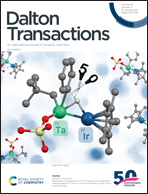A case study on the conversion of Li/Cl phosphinidenoid into phosphinidene complexes†
Abstract
N,N-Diphenylamino- and N,N-dicyclohexylamino-substituted dichlorophosphane W(CO)5 complexes 1a,b were used to generate thermally very labile Li/Cl phospinidenoid W(CO)5 complexes 2a,b. The formation of transient complex 2a was confirmed via low-temperature 31P{1H} NMR spectroscopy, but further strong evidence for the formation of transient complexes 2a,b was obtained from reactions with methanol and methylamine as formal E–H insertions (E = O, N) furnished complexes 3a,b and 4a. By using toluene in the absence of donor ligands, the primarily nucleophilic complexes 2a,b were converted into electrophilic terminal phosphinidene complexes 5a,b which was deduced from specific trapping reactions using tolane, 1-pentene and 1-hexene and thus obtained 1H-phosphirene 6 and phosphirane complexes 7 and8. The state-of-the-art DFT calculations reveal insights into the possible reaction pathways and exclude a direct reaction of 2a,b with alkene trapping reagents.



 Please wait while we load your content...
Please wait while we load your content...